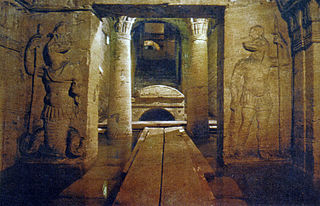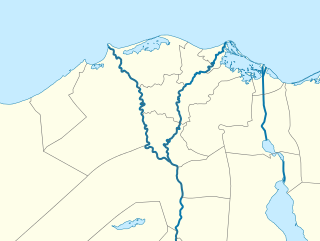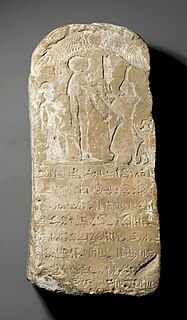Related Research Articles

Abydos is one of the oldest cities of ancient Egypt, and also of the eighth nome in Upper Egypt. It is located about 11 kilometres west of the Nile at latitude 26° 10' N, near the modern Egyptian towns of El Araba El Madfuna and El Balyana. In the ancient Egyptian language, the city was called Abdju. The English name Abydos comes from the Greek Ἄβυδος, a name borrowed by Greek geographers from the unrelated city of Abydos on the Hellespont.

Amarna is an extensive Egyptian archaeological site that represents the remains of the capital city newly established and built by the Pharaoh Akhenaten of the late Eighteenth Dynasty, and abandoned shortly after his death. The name for the city employed by the ancient Egyptians is written as Akhetaten in English transliteration. Akhetaten means "Horizon of the Aten".

Memphis was the ancient capital of Inebu-hedj, the first nome of Lower Egypt. Its ruins are located near the town of Mit Rahina, 20 km (12 mi) south of Giza in Greater Cairo, Egypt.

Buto, Butus or Butosus was an ancient city located 95 km east of Alexandria in the Nile Delta of Egypt. What in classical times the Greeks called Buto stood about midway between the Taly (Bolbitine) and Thermuthiac (Sebennytic) branches of the Nile, a few kilometers north of the east-west Butic River and on the southern shore of the Butic Lake.

The Nile Delta is the delta formed in Lower Egypt where the Nile River spreads out and drains into the Mediterranean Sea. It is one of the world's largest river deltas—from Alexandria in the west to Port Said in the east, it covers 240 km (150 mi) of Mediterranean coastline and is a rich agricultural region. From north to south the delta is approximately 160 km (99 mi) in length. The Delta begins slightly down-river from Cairo.

Edfu is an Egyptian city, located on the west bank of the Nile River between Esna and Aswan, with a population of approximately sixty thousand people. Edfu is the site of the Ptolemaic Temple of Horus and an ancient settlement, Tell Edfu. About 5 km (3.1 mi) south of Edfu are remains of ancient pyramids.

Avaris was the capital of Egypt under the Hyksos. It was located at modern Tell el-Dab'a in the northeastern region of the Nile Delta, at the juncture of the 8th, 14th, 19th and 20th Nomes. As the main course of the Nile migrated eastward, its position at the hub of Egypt's delta emporia made it a major administrative capital of the Hyksos and other traders. It was occupied from about 1783 to 1550 BC, or from the Thirteenth Dynasty of Egypt through the Second Intermediate Period of Egypt until its capture by Ahmose I, the first Pharaoh of the Eighteenth dynasty. The name in the Egyptian language of the 2nd millennium BC was probably pronounced *Ḥaʔat-Wūrat 'Great House' and denotes the capital of an administrative division of the land. Today, the name Hawara survives, referring to the site at the entrance to Faiyum. Alternatively, Clement of Alexandria referred to the name of this city as "Athyria".

Naucratis or Naukratis was a city of ancient Egypt, on the Canopic branch of the Nile river, and 45 mi (72 km) southeast of the open sea and Alexandria. It was the first and, for much of its early history, the only permanent Greek colony in Egypt; it was a symbiotic nexus for the interchange of Greek and Egyptian art and culture.

The catacombs of Kom El Shoqafa is a historical archaeological site located in Alexandria, Egypt, and is considered one of the Seven Wonders of the Middle Ages.

Pithom also called Per-Atum or Heroöpolis or Heroonopolis was an ancient city of Egypt. Multiple references in ancient Greek, Roman, and Hebrew Bible sources exist for this city, but its exact location remains somewhat uncertain. A number of scholars identified it as the later archaeological site of Tell El Maskhuta. Others identified it as the earlier archaeological site of Tell El Retabeh.

Kom el-Hisn is a Nile Delta settlement dating back to the Old Kingdom of Egypt with parts dating to the Middle Kingdom. Its location in the 3rd nome of Lower Egypt, or "Estate of the Cattle", focus on the goddess Hathor, as well as faunal and textual evidence suggests it played a role in transporting cattle between regions. Whether or not it was a self-sufficient town or built solely to support the temple is currently unknown.

Tarrana, known in classical antiquity as Terenuthis, is a town in Monufia Governorate of Egypt. It is located in the western Nile Delta, circa 70 km north-west of Cairo, between the southern prehistoric site of Merimde Beni-salame and the northern town of Kom el-Hisn. The ruins of ancient Terenuthis are found at Kom Abu Billo, northwest of the modern city.
The use of urban planning in ancient Egypt is a matter of continuous debate. Because ancient sites usually survive only in fragments, and many ancient Egyptian cities have been continuously inhabited since their original forms, relatively little is actually understood about the general designs of Egyptian towns for any given period.

Kom El Deka is a neighborhood in Alexandria, Egypt. Archaeological Site in Alexandria, Kom Al Dikka was a well-off residential area in Graeco-Roman times, with lovely villas, bathhouses and a theatre. The area was known at the time as the Park of Pan, a pleasure garden where citizens of Alexandria could indulge in various lazy pursuits. Although the ruins aren't terribly impressive in scale, they remain a superbly preserved ode to the days of the centurion and include the 13 white-marble terraces of the only Roman amphitheatre found in Egypt. It contains a historical theater that dates back to the Roman era.

Saft el-Hinna is a village and an archaeological site in Egypt. It is located in the modern Al Sharqia Governorate, in the Nile Delta, about 7 km southeast of Zagazig.

Tell el-Balamun first known as Smabehdet, is an ancient city in Egypt dating from 2400 BC. It was once a port city on an estuary of the Nile, but is now inland of the Mediterranean Sea. In Classical times it was known as Diospolis Inferior. It has a complex of temples.

The Research Centre in Cairo, Polish Centre of Mediterranean Archaeology University of Warsaw, is the only Polish scientific research institution in Africa and the Middle East., where it has operated since 1959 in Cairo. The mission of the Research Centre is to develop and expand Polish research in the region, particularly in the Nile Valley. It is operated by the Polish Centre of Mediterranean Archaeology, an independent research institute of the University of Warsaw. The PCMA Cairo Research Centre is located in two buildings situated in close proximity to one another in the Cairo Heliopolis district — in antiquity the centre of a religious cult and the location of the Egypt's reputedly largest temple.

Kom Firin is an archaeological site in Egypt, located in the southwestern border of the Nile Delta, just west of Kom el-Hisn. Most of the archaeological informations regarding the site were obtained from the 2002–2010 excavation campaign organized by the British Museum and led by Neal Spencer.

El Delengat (Egyptian Arabic: الدلنجات is a city in Beheira Governorate in Egypt
References
- ↑ Robert Schiestl, Tomasz Herbichː Kom el-Gir in western Delta, in Egyptian Archaeology 43, Spring 2013, pp. 28-29